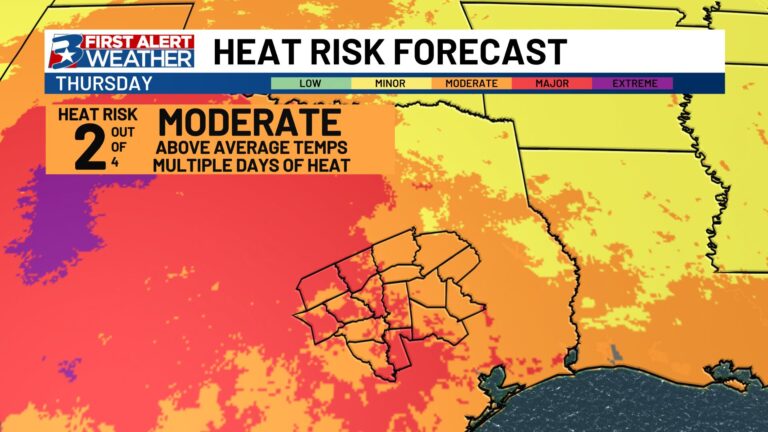NOAA: July 2023 ranked as the United States 11th hottest
August 8, 2023 (NOAA) – July 2023 was a hot and stormy month for the U.S., with flooding rain and scorching temperatures impacting much of the nation.
2023 is also marked by the most billion-dollar disasters for the first seven months of any year since 1980, according to scientists from NOAA’s National Centers for Environmental Information.
Below are more takeaways from NOAA’s latest monthly U.S. climate report:
CLIMATE BY THE NUMBERS
JULY 2023
The average temperature across the contiguous U.S. last month was 75.7 degrees F (2.1 degrees above average), with July 2023 ranking as the 11th-hottest July in the 129-year climate record.
Arizona, Florida, Maine and New Mexico had their warmest Julys on record, while an additional 13 states saw their top-10 warmest July on record.
The average July precipitation was 2.70 inches (0.08 of an inch below average), ranking in the middle third of the historical record.
Arizona, Idaho and Minnesota each had their third-driest July on record, while California and New Mexico had one of their top-10 driest Julys on record. Connecticut and Vermont experienced their second-wettest July on record. Massachusetts, Michigan, New Hampshire, New York, Oklahoma, Pennsylvania and Rhode Island all had a July ranking among top-10 wettest on record.
Year to date (YTD, January through July 2023)
The YTD average temperature for the contiguous U.S. was 53.0 degrees F (1.7 degrees above average), ranking as the 16th-warmest such YTD on record.
Florida recorded its warmest such YTD, while Connecticut, Delaware, Louisiana, Maryland, Massachusetts, Mississippi and New Jersey each ranked second-warmest for the January–July period. An additional 20 states had a top-10 warmest such YTD period while no state experienced a top-10 coldest YTD for this seven-month period.
The average precipitation for January-July 2023 was 18.41 inches (0.32 of an inch above average), ranking in the middle third of the record.
New Hampshire had its fifth-wettest such YTD on record, while Massachusetts and Vermont ranked among their top-10 wettest for this period. Conversely, precipitation was below average across parts of the Northwest, eastern Plains, Southwest, central Mississippi Valley, Mid-Atlantic and along parts of the Gulf during the January–July period. Maryland had its 10th-driest January–July on record.
A map of the U.S. plotted with 15 weather and climate disasters each costing $1 billion or more that occurred between January and July, 2023.
Billion-dollar disasters
There have been 15 individual weather and climate disaster events confirmed for January through July 2023, each with losses exceeding $1 billion. This is the highest number of billion-dollar disasters ever recorded for the first seven months of a year since NOAA began tracking these events in 1980. The 15 events include:
13 Severe Weather EventsOne Winter Storm EventOne Flooding Event
These events caused 113 direct and indirect fatalities and produced more than $39.7 billion in damages (Consumer Price Index (CPI)-adjusted).
Since 1980, the U.S. has sustained 363 separate weather and climate disasters where overall damages/costs reached or exceeded $1 billion (including CPI adjustment to 2023). The total cost of these 363 events exceeds $2.590 trillion.
A map of the U.S. plotted with significant climate events that occurred during July 2023. Please see article text below as well as the full climate report highlights at http://bit.ly/USClimate202307
Other notable highlights from this report
Record heat scorched the Southwest in July:
July was the warmest month on record for the state of Arizona and New Mexico by nearly 2 degrees F. Across the Southwest, 36 counties each had their warmest July on record, while an additional 63 counties ranked in the top-10 warmest for the month.Phoenix, Arizona, had an average temperature of 102.8 degrees F for the month of July — the hottest month on record for any U.S. city. Contributing to the record, Phoenix had 31 consecutive days of temperatures above 110 degrees F from June 30 to July 30 — breaking the previous record of 18 days set in 1974.On July 16, California’s Death Valley soared to 128 degrees F, setting a daily-temperature record, and reported its hottest midnight temperature on record at 120 degrees F on July 17.
Severe storms, catastrophic flooding struck some communities:
On July 10, severe storms brought devastation and flooding to portions of the Northeast, as areas reported up to eight inches of rain within a 24-hour period. Montpelier, Vermont, received a record-breaking 5.28 inches of rain, flooding the city and damaging thousands of homes and businesses.From July 18-19, a historic flash flood occurred over portions of Kentucky and Illinois after some areas received up to 12 inches of rainfall, causing significant damage and trapping residents in their homes. Mayfield, Kentucky, received 11.28 inches of rain in a 24-hour period, likely breaking the state record for 24-hour rainfall.From July 24-25, an extreme thunderstorm outbreak produced more than 19,000 lightning strikes causing dozens of new wildfires in the state of Alaska. Overall, 2023 ranks as the second-lowest fire season, by acres burned, in the past 30 years for the state.







